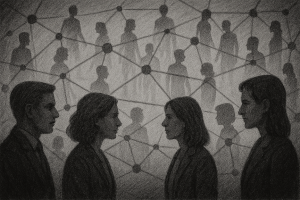An engineer in Pune finishes his corporate workday at 6:30 pm, only to open his laptop again at 7:00 pm for a freelance project with a client in Dubai. A young FMCG executive in Hyderabad spends her weekends building a small but growing online brand. A teacher in Delhi records YouTube lessons late into the night, watched by thousands of eager learners across the country. These stories may sound like exceptions, but they are increasingly the rule. Moonlighting and side hustles have moved from the margins to the mainstream, and with them comes a profound shift in how we understand employment, loyalty, and professional identity.

Rise of Side Hustles: From Fringe to Mainstream
Across the world, statistics confirm that this is no longer a fringe behaviour. In the United States, nearly half of all working adults now report having a side hustle, and among millennials, the proportion is even higher. In India, a study in the FMCG sector revealed that eight out of ten employees admitted to moonlighting. Among IT professionals, more than forty percent said they viewed dual employment favourably. Globally, side hustlers earned an average of almost nine hundred dollars a month in 2024, up significantly from the previous year. Taken together, these figures show that what once might have been treated as a transgression is fast becoming a norm of working life.
Motivations Behind Moonlighting
The motivations that fuel this shift are complex and multi-layered. For many employees, financial security remains a key driver. Rising inflation and uneven wage growth mean that relying on a single income stream feels increasingly risky. Others are motivated by personal fulfilment and the desire to explore passions or entrepreneurial ambitions beyond the boundaries of their day jobs. Digital infrastructure has made it easier than ever to monetise skills: platforms for tutoring, coding, content creation and online retail have lowered entry barriers dramatically. But beneath these economic and technological drivers lies something more fundamental – a change in the psychological contract between employer and employee. Workers no longer expect lifelong stability from a single organisation, and employers are no longer able to promise it. Side hustles, then, are as much about identity and autonomy as they are about money.

Organisational Dilemma: Risk or Opportunity?
For organisations, the rise of moonlighting brings both risks and opportunities. On one hand, there are concerns about productivity, divided focus and the possibility of burnout. Balancing two jobs can create fatigue that inevitably spills into the performance of the primary role. On the other hand, employees often bring new skills, ideas and networks back into their full-time jobs, enriching the organisation in unexpected ways. Cultural implications are equally significant. Traditional notions of loyalty are being tested. For some companies, this creates unease and leads to stricter rules and surveillance. For others, especially startups and creative firms, it is seen as evidence of an entrepreneurial spirit worth nurturing. The legal landscape, particularly in India, only adds to the complexity. Moonlighting is not explicitly illegal, but most contracts include exclusivity or non-compete clauses, creating a grey zone that leaves room for tension.

Leadership Response: Ban, Embrace, or Balance?
The leadership dilemma is stark. Should companies ban moonlighting outright, risking disengagement and secrecy? Should they embrace it fully, risking a dilution of focus? Should performance be measured by hours clocked or by outcomes delivered? How can intellectual property be protected without stifling employees’ growth? Each organisation will have to find its own balance, but what is clear is that the issue cannot be ignored or brushed aside as a passing fad.
Leaders who respond with rigidity may find themselves out of step with their employees, while those who choose to adapt can position their organisations to benefit from this shift. Adapting begins with acknowledgement – understanding the reality of how widespread side hustling is, rather than pretending it does not exist. It requires clarity in communication, ensuring that employees know what is permissible, what must be disclosed, and where conflicts of interest will not be tolerated. It also requires creativity in channelling this energy. By offering structured opportunities for intrapreneurship, innovation labs or internal projects, companies can provide sanctioned pathways that satisfy employees’ hunger for variety and growth while keeping their energy aligned with organisational goals. Above all, it requires moving away from an obsession with time and presence, and focusing instead on outcomes, collaboration and impact.
The Future of Work: Embracing the Gig Mindset

The future of work will not be defined by a return to rigid contracts of loyalty in exchange for stability. It will be defined by a more fluid understanding of how people build careers, manage risk and pursue identity through multiple streams of activity. For organisations, the challenge is not to suppress this trend but to learn how to live with it and even thrive because of it. Those that manage to create environments of trust and transparency, while safeguarding well-being and intellectual property, will find that side hustles do not necessarily weaken commitment. In fact, they can strengthen it by allowing employees to bring their full selves – their skills, passions and entrepreneurial spirit – into the workplace.
The Path Forward
Moonlighting and side hustles are not a passing disruption. They are a symptom of deeper currents reshaping work in our time. Organisations that recognise this shift and adjust with agility will be better positioned to attract, retain and inspire the talent they need. Those that cling to outdated notions of exclusivity may soon find themselves left behind. The gig mindset inside firms is not a problem to be eliminated. It is a reality to be understood, managed and harnessed for the future.


